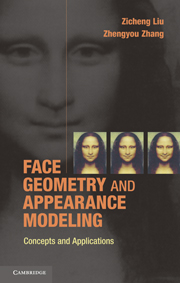1 - Introduction
Published online by Cambridge University Press: 01 June 2011
Summary
Face image processing has been a fascinating topic for researchers in computer vision, computer graphics, and multimedia. Human face is so interesting to us partly because of its familiarity. We look at many different faces every day. We rely on our face as a communication channel to convey information that is difficult or impossible to convey in other means. Human faces are so familiar to our visual system that we can easily recognize a person's face in arbitrary lighting conditions and pose variations, detect small appearance changes, and notice subtle expression details. A common question in many researchers' minds is whether a computer vision system can process face images as well as a human vision system.
Face image processing has many applications. In human computer interaction, we would like the computer to be able to understand the emotional state of the user as it enriches interactivity and improves the productivity of the user. In computer surveillance, automatic face recognition is extremely helpful for both the prevention and investigation of criminal activities. In teleconferencing, face image analysis and synthesis techniques are useful for video compression, image quality enhancement, and better presentation of remote participants. In entertainment, face modeling and animation techniques are critical for generating realistic-looking virtual characters. Some video games even allow players to create their personalized face models and put “themselves” in the game.
- Type
- Chapter
- Information
- Face Geometry and Appearance ModelingConcepts and Applications, pp. 1 - 16Publisher: Cambridge University PressPrint publication year: 2011



